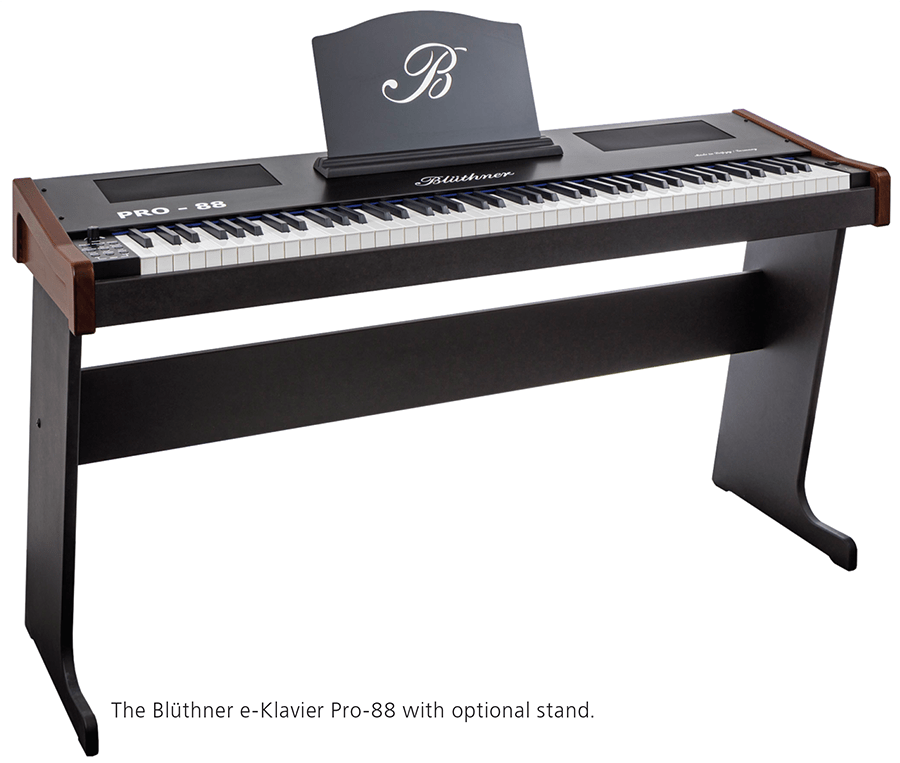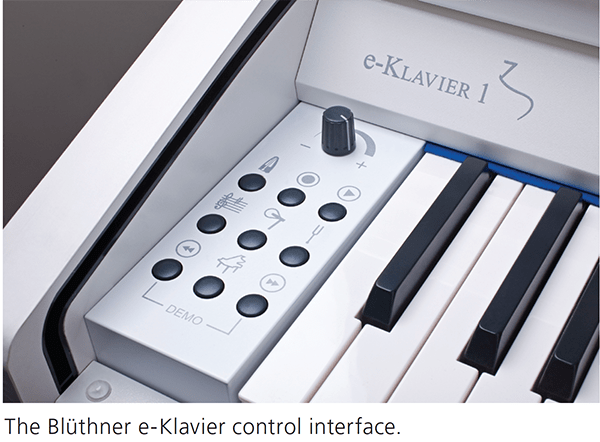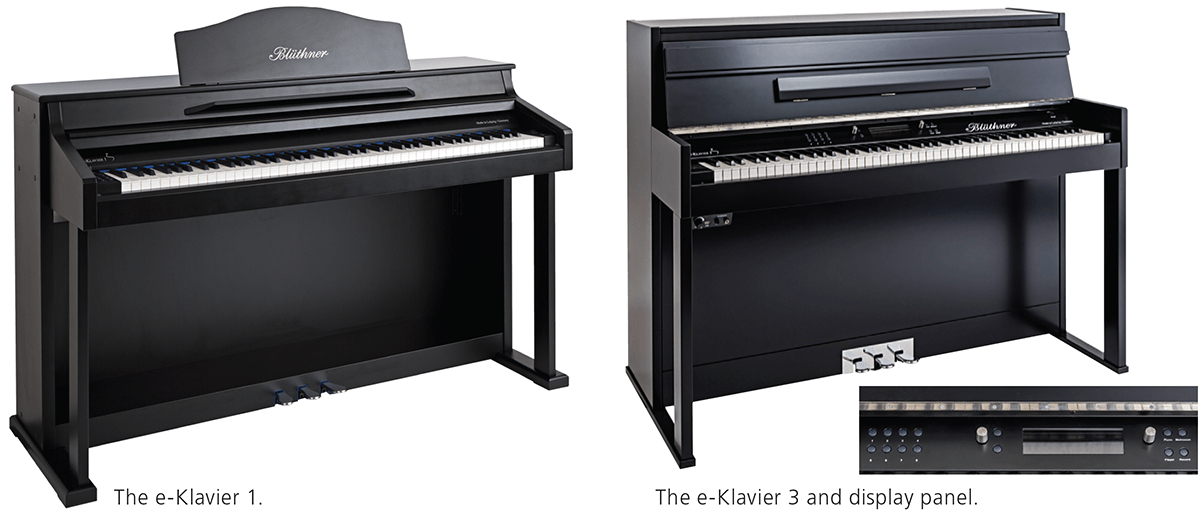
The e-Klavier, which Blüthner calls "an acoustic piano simulation," has been developed, designed, and manufactured in the same factory in Leipzig, Germany, as the company's acoustic pianos. Blüthner says that because the design of the e-Klaviers is guided by their philosophy of Authentic Acoustic Behavior, these instruments come closer to the character of a true acoustic instrument than any digital piano has ever come before. According to the company, Authentic Acoustic Behavior is a unique approach to sampling and sound modeling that allows the e-Klavier to reproduce the effect of the aliquot (fourth) strings used in Blüthner's acoustic models. This system also allows for the reproduction of advanced harmonics, such as the coincident partials produced when two notes are played simultaneously, or the sounds of dampers lifting off the strings. The speaker systems and amplifiers, unique to the e-Klavier, were designed by Günter Philipp of PCL Audio.
The e-Klavier line currently comprises five models in three physical styles: the PRO-88, a professional performance keyboard in slab (portable) style, with optional stand; the e-Klavier 1, 2, and 3, in traditional vertical-piano style; and the Pianette, a vertical in a modern-looking furniture design. I had the opportunity to try the PRO-88, the e-Klavier 1, and the e-Klavier 3. To gauge the usability and simplicity of each piano's user interface, I elected to try the instruments without consulting a user's manual. I found the interface both elegant and easy to use. Access to all sounds and features is accomplished with just nine sturdy, backlit buttons and a volume-control knob. The e-Klavier 3 has, in addition, two knobs and an LCD display for scrolling through the editor menu, with which the user can adjust various performance parameters, such as voicing and tuning. Especially with the e-Klaviers 1 and 3, the limited number of buttons lent an illusion of pianistic realism: that the instruments are not entirely digital (when, of course, they are).

The e-Klavier 1 offers 25 Blüthner-created sounds, including Grand Piano, Harpsichord, Strings, and Electric Piano (similar to Fender Rhodes), as well as combinations of these sounds. The e-Klavier 3 offers 28 Blüthner sounds in similar varieties, plus the 128-sound General MIDI soundset. The PRO-88 offers 28 Blüthner sounds. All are easy to scroll through and access with the control interface. Other features available on all three models include touchweight adjustment, which simulates touchweight changes by altering the key sensors' response to the player's touch; historical tunings, metronome, transposition, and an internal song recorder; and digital effects, such as reverb, chorus, phaser, and tremolo. Blüthner is developing the option for these instruments to download new sounds via the Internet; an updated grand-piano sample is now available, and an updated harpsichord sample is forthcoming.
Prominently featured in all three instruments is the sample of Blüthner's Model 1 concert grand, which, it's worth noting, sounds quite different from an American Steinway Model D concert grand. At best, the Blüthner sound is clearer, especially in the highest treble range, and the bass is more restrained, even well mannered. At worst, the sound might be perceived by some as bright, and without a round resonance in the bass. Personally, I find the Model 1 to be a refreshing change.
Altogether, these keyboards played extremely well — using the Grand Piano setting of all three instruments, I was able to navigate Debussy, Liszt, Mozart, and Piazzolla remarkably well. Mozart's Piano Sonata No.13 in B-flat major, K.333, was a particular highlight. Passagework was effortlessly luminous at mezzo piano, with subtle gradations easily attained at this dynamic level and below, which compared favorably with the experience of playing a high-quality acoustic piano. The e-Klavier's Fatar action, graded by hammer weight into four weight zones, undoubtedly contributed to its realistic feel. In the first big theme, in A-flat major, of Liszt's Funérailles, volumes across all registers were easy to balance, whereas the bass of an American Steinway (or a sample of a similar instrument) can easily overwhelm. As I ascended the model line from PRO-88 to e-Klavier 3, the sound and playing experience improved and became more realistic — an experience only enhanced by the e-Klavier 3's ivory-textured keys and real acoustic-piano soundboard. If you are a serious pianist looking for a digital instrument on which to regularly practice, the e-Klavier 3 is the one for you. However, all three models offer piano samples completely appropriate for professional use.

I then spent some time with the other voices available on the e-Klaviers. The electric-piano sounds were completely convincing — funky and driving or delicate and dreamlike, according to the specialties of the various great vintage instruments of this genre. Harpsichord samples were realistic enough to temporarily approximate the feeling of playing baroque music on a period instrument, if lacking in the subtleties of timbre and, obviously, the action feel of the genuine article. Stringed-instrument samples in all three instruments were not the best I've tried, but were fun to play with.
The main drawback of these instruments, most noticeable in the e-Klaviers 1 and 3, was the sound quality of the onboard amplifier and speakers: a bit hollow and lifeless. Interestingly, the PRO-88, though with fewer and/or lower-powered speakers, sounded a little more realistic, perhaps because of different speaker positions, or the absence of a bulky, sound-absorbing cabinet. Particularly with the Grand Piano sound, there was a marked improvement in realism and quality with all models when I listened through high-quality headphones as I played — all three always sounded clear and dynamic at all frequencies. These instruments also have Bluetooth connectivity, which allows the user to use the onboard speaker system as a home stereo. I suspect, however, that the serious listener would prefer a quality home stereo system.
Overall, these three models of Blüthner e-Klavier are exceptional instruments for pianists looking for a digital playing experience that is as realistic as possible. This realism, particularly of the piano sounds through headphones, makes the e-Klavier line, in my opinion, outshine offerings I've played from other major makers. The PRO-88, though at 57 pounds (without optional stand) perhaps a little heavy for travel, would still make an excellent portable keyboard for a touring pianist. Its slim profile and realistic playing experience place it near the top of keyboards in this category. The e-Klavier 1 provides a more elegant piano-like appearance for someone seeking, for an apartment or home, an instrument with a footprint smaller than that of a vertical acoustic. The e-Klavier 3 is easily the most elegant looking of the entire line, with case styling that could pass for an acoustic piano's, right down to the built-in soundboard visible from the back. The e-Klaviers 1 and 3 are excellent home or apartment instruments that would also be suitable practice-room substitutes for upright and small grand pianos.
Blüthner e-Klavier model specifications
| Model | PRO-88 | e-Klavier 1 | e-Klavier 3 |
| Style | Slab | Vertical | Acoustic-look vertical |
| H x W x D, inches | 5 x 55 x 17 | 36 x 57 x 22 | 42 x 55 x 25 |
| Weight, lbs. | 57 | 198 | 231 |
| Speakers & amplifier | 2 x 5"
2 x 30W | 2 x 6"
2 x 50W | 2 x 10", 2 x 4"
4 x 50W |
| Keyboard | 4-zone graded. “grand touch" with escapement | 4-zone graded, “grand touch" with escapement | 4-zone graded, wooden keys
with ivory feel |
| Sounds | 25 + 5 effects | 25 + 5 effects | 28 + 128 general midi |
Song recorder
and capacity | 1 channel, 30,000 note | 1 channel, 30,000 note | 2 channel, 100 song internal, unlimited external |
| Polyphony | 128 | 128 | 128 |
| Bluetooth connectivity | No | No | Yes |
| Other features | Stand sold separately | Integrated stand | LCD display, acoustic-style soundboard |
| Base MSRP | $3,164 | $4,924 | $7,709 |